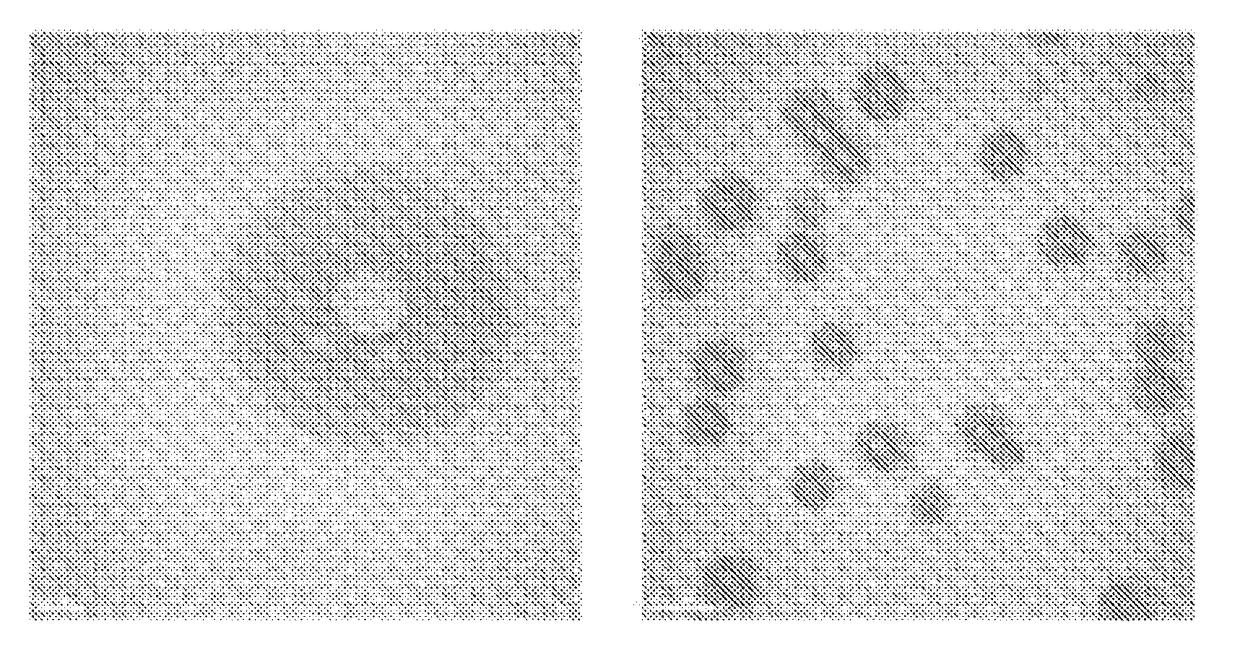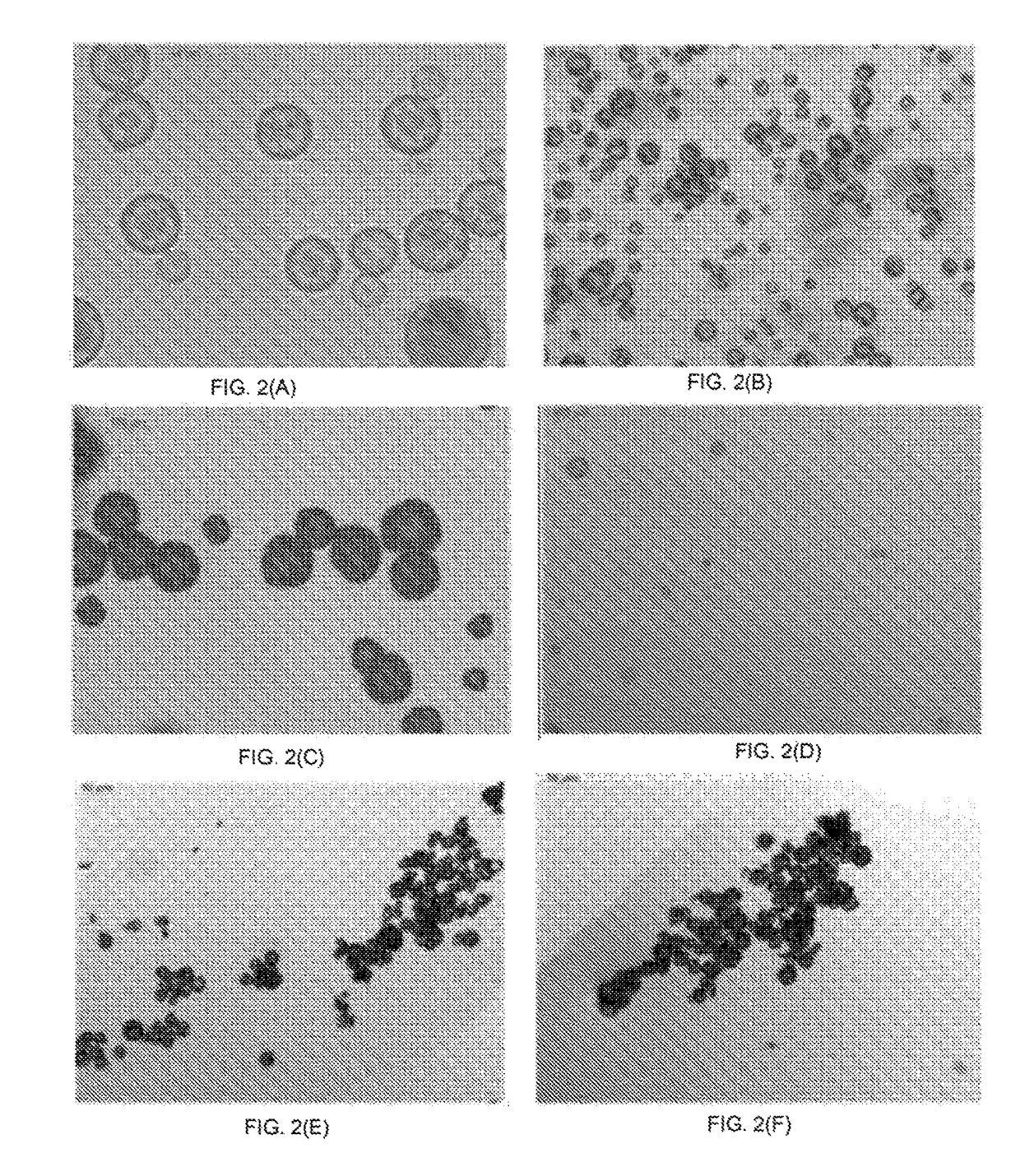On the other hand, the interconversion velocity, and very particularly for the reverse thermal process B→A, is greatly affected when these compounds are dispersed directly on a
solid environment.
This is a significant problem since for many uses, these compounds are used in a
solid state.
It is evident that the direct deposition of the material on a surface would have the main
disadvantage of being overly exposed to external factors.
Mechanical actions or chemical attacks (solvents, acids-bases, reagents) would cause a rapid degradation of the coating.
Firstly, the absence of
solvent directly influences the energy of the absorption bands, altering, in effect, the absorption spectrums of the states of the photochromic
system (and thus, the color thereof).
Secondly, the absence of solvents and the presence of steric impediment due to the polymeric chains located around the photochromic molecule or other photochromic molecules in the crystalline phase alter the interconversion
kinetics, significantly reducing the velocity even, in some cases, losing the reversibility of the process.
This consequence could be very negative in those systems which require a quick
recovery to the initial state of the photochromic material.
1. One of the methods used the most during recent years consists of dispersing the photochromic material of interest in nanostructured porous materials such as zeolites,
mesoporous silica sheets or
mesoporous silica particles (e.g. DE102006033906, EP1849844). The presence of cavities of nanometric scale in these materials allows the photochrome molecules to disperse evenly inside the pores of the matrix. This gives a certain degree of
physical protection to the photochromes when the porous-photochrome matrix
system is used as a coating. Furthermore, the pores guarantee the photochromic molecules a sufficient free volume around them so that they can maintain the interconversion
kinetics observed in solution. In
spite of this, the presence of pores in contact with the outside would not prevent the possibility of solvents and / or other
chemical agents entering inside and degrading the photochromic material. Furthermore, so that the photochromic molecules enter the pores and interact with the porous matrix, the two components must have a certain compatibility, which limits the use of this methodology for some types of systems.
2. For the purpose of having micro and / or nano cavities whereon the photochromic molecules disperse such that these molecules have the desired mobility, it has been proposed to include photochromes inside of dendrimers or hyper-branched polymers (e.g. WO2009072988). At temperatures higher than 10° C. and thanks to the high flexibility of the side branches of these polymeric systems, the included photochrome molecules have suitable mobility to maintain their photoactivity to a large extent. In the case of dendrimers, these are formed by a
solid cortex and a flexible core with internal cavities where small amounts of
solvent and photochromic molecules with a certain affinity for the functional groups present inside them may be included. On the other, hand, the hyper-branched polymers are globular polymers of amphiphilic nature. Their apolar outside allows them to interact with apolar matrices and their polar core is a carrier of organic polar additives (in this case, the photochromes). The photochromic molecules are physically included in the
system by means of co-
precipitation such that they are distributed in a homogenous manner in the matrix of interest without modifying the properties thereof.
3. Instead of creating a micro / nano environment for the photochromic material which guarantees the preservation of the photochromic activity observed in solution, in other studies, attention has been centered on developing new photochromes with special interconversion mechanisms. In particular, molecules have been designed for which the conversion between the two states of the system does not require large conformational changes, such that the
kinetics of this process is only very slightly affected by the encapsulation thereof in the rigid matrices (A fast molecule that colors only under UV Light, Y. Kishimoto, J. Abe, J. Am. Chem. Soc. 2009, 131, 4227-4229). These molecules, based on bisimidazol systems, undergo a photoinduced homolythic breaking a C—N bond to pass from one state to another, giving rise to the formation of two free radicals which quickly recombine to return to the initial system independently from the medium. However, only a very limited number of the molecules have these properties, which limits their use based on the necessary requirements in each case (i.e. change of desired color).
4. Instead of creating a free volume where the photochrome may have high mobility, another strategy developed during recent years consists of introducing the photochromic molecules in a medium of low rigidity where they can move easily. For example, this may be achieved by means of including the photochromic compounds in polymeric matrices with a low
glass transition temperature (Tg), such that they have a
viscous liquid behavior at
room temperature. As a consequence of this, the photochromic molecules have sufficient freedom of movement to maintain to a large extent their interconversion kinetics. However, said polymeric matrices of low Tg have poor mechanical properties, which is why their use is not feasible as a coating in the majority of uses. In order to overcome this drawback, it is proposed to cover said matrices with other more mechanically resistant materials. For example, an approach of this type consists of covalently joining the photochromic molecules of interest to oligomers of low Tg, which are wound in a spontaneous manner around the photochrome and subsequently are dispersed in a rigid polymeric matrix. In this way, the nanometric environment of the photochromic molecules is sufficiently flexible so as to allow the rapid interconversion thereof between the two states, at the same time that the outer
polymer of high Tg provides the desired mechanical and structural properties to the material (e.g. WO2006024099, US2009093601, U.S. application Ser. No. 11 / 574,654 (published as US2009 / 0093601), WO2009121148 and WO2009146509). In the systems cited in the
technical literature, an
oligomer-photochrome ratio around 1 / 1 is used and in a rather low proportion with respect to the total
mass of the rigid polymeric matrix to minimize the changes to the mechanical properties of said matrix.
5. An approach closely related to the previous methodology has been developed and patented by Koninklijke Philip
Electronics NV (WO 03 / 001555). In this case, the photochromic compound is included in particles with core-shell structures, which may be dispersed in a rigid matrix of interest (for example, in a
polymer with Tg higher than 50° C.). The core of said capsules is formed by polymers of low Tg (lower than 40° C., preferably lower than 10° C.), where the photochromic molecules are included as
dopant by means of swelling. In said core, the photochromic molecules have sufficient mobility so as to preserve the rapid interconversion between the two states thereof. On the other hand, the cortex, composed of cross-linked polymers of high Tg, maintains the integrity of the core and consequently, of the included photochrome and protects it from reactive substances which may alter the properties thereof. Furthermore, the good mechanical properties of said cortex allow the encapsulated photochromic system to be included in coatings. A problem presented by this approach is that the behavior of the system is very dependent on the temperature and is limited by the Tg of the core of the particles. For example, if said Tg is ˜10° C., the system could have different interconversion velocities between its two states as a function of what the thermal contrast between day and night is. A similar approach based on core-shell capsules has been developed by the American Optical Corporation (U.S. Pat. No. 4,367,170). In this case, the core is formed by a resinous organic material in which the photochromic compound is dispersed; regarding the cortex, this is formed by a suitable inorganic material. As in the preceding methodology, the cortex protects the core from external factors and allows the
capsule-photochrome system to be included in rigid polymeric matrices for an possible use as a coating. In both cases, a problem which may be encountered in this type of approaches is the difficulty to dissolve some types of photochromes in organic resins or in polymers of low Tg.
 Login to View More
Login to View More 


